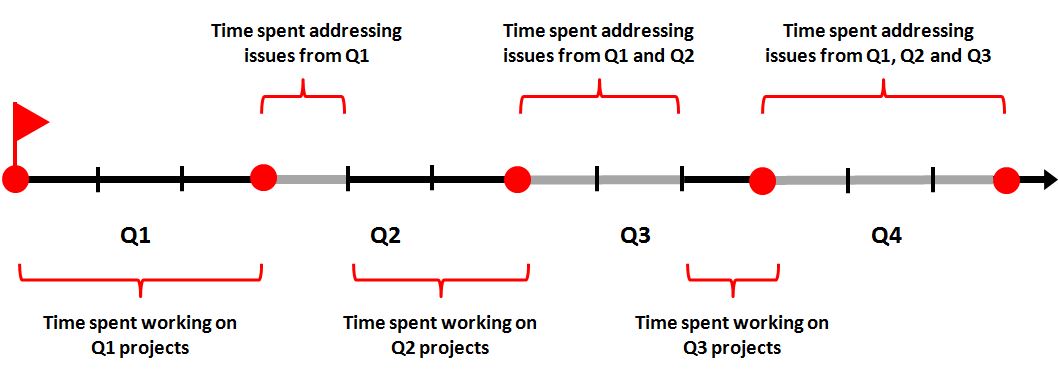There is a multitude of potential problems that await the company without proper project portfolio management processes in place. Initially lack of portfolio management manifests in terms of reluctance to kill weak project proposals, project being selected based on politics or emotions and lack of strategic criteria in the project selection.
What are the immediate results of such ad-hoc approach? There are at least two: too many projects are added to the pipeline and many – if not the majority – of these ventures are of low-value to the organization.
These two aspects also have several long-term effects. Because the company resources are too thinly spread across multiple initiatives, delivery times tend to increase and the final quality of the products tends to suffer, because the employees are scrambling between multiple ventures, missing deadlines and making mistakes that are harder and harder to fix as the projects progress from initiation to the close-out stages.
The project failure rates increase either because the initial ideas were of poor value or because – even if they were indeed good ideas – the project teams fail to deliver quality products. As a result, the proverbial “product winners” that every executive craves to see in his company offerings are very hard to come by.
If one can use the sniper analogy, instead of placing few well-aimed shots from a high-quality rifle, the company fires multiple blasts from the shotgun hoping that some of the pellets fired will hit the targets.
Another interesting phenomenon that I have observed at multiple organizations is the accumulation of the technical debt that eventually eclipses all of the high-value project work the company can deliver instead.
Let me demonstrate this by a real-life example (see Figure 1). I once worked at an IT department of a large financial institution. The executive management of the department had a very interesting approach to their strategic planning; at the beginning of every year they would examine the previous year’s performance statistics and discover that the information technology group has delivered, say, fifty projects. They would go the strategic planning meeting of the entire company and claim something to the effect of:
Last year we delivered sixty projects. In order to exceed the expectations this year we will accomplish eighty projects!
Obviously all of the people in the room were very happy with these new commitments and the new plan would be approved. The interesting aspect of this story is that none of the IT managers even bothered to compare the relative complexity of the old versus new projects. Moreover, not one of them even asked a simple question, “How successful were we with the sixty projects we delivered the last year?”
So, they would arrive back at their offices, present the new project list to their employees and the hard work would commence. The IT team would be assigned the first twenty of the planned eighty of the initiatives (for simplicity let us assume that eighty projects have been proportionally divided between four quarters). Since they had troubles delivering fifteen projects per quarter and the complexity of the projects usually does not decrease with time, all of the project teams would experience serious issues with the timely delivery of the initiatives assigned to them.
The project managers would tell the executives about the challenges, but they would reply with something along the lines of, “Just roll up your sleeves and works harder”. At the end of the quarter the IT management would report that the projects allocated to the quarter have been delivered successfully, although in reality there would be some serious issues, bugs and deficiencies. What was the response of the business side of the organization? Great! Here are the next twenty projects! See you at the end of Q2.
What would happen in the second quarter is that the first month of it would have to be spent addressing the issues left over from the first quarter, which would leave the entire department with two months to deliver the amount of work they could not accomplish in three months in the first place!
Figure 1
The history repeats again with the project managers being told to “sweep their problems under the rug” and report to the business side of the organization that everything is working fine. At the end of the second quarter business hands over to IT additional twenty projects. The only problem was that the project teams had to spend two out of the three months in the third quarter addressing the issues generated in Q1 and Q2.
By the time the fourth quarter rolled around, the department had absolutely no time to devote to the Q4 projects as its man-hours were completely invested in correcting the problems generate in Q1, Q2 and Q3 …
This particular example has been somewhat fast-forwarded for illustrational purposes; sometimes this entire cycle took only a year, sometimes it stretched to three or four years. But the end-result of not having proper portfolio management and strategic planning has always been the same: either a screeching halt to all the company projects or a realization that nothing can be done with the growing technical debt problem.
About the Author
Jamal Moustafaev, MBA, PMP – president and founder of Thinktank Consulting is an internationally acclaimed expert and speaker in the areas of project/portfolio management, scope definition, process improvement and corporate training. Jamal Moustafaev has done work for private-sector companies and government organizations in Canada, US, Asia, Europe and Middle East. Read Jamal’s Blog @ www.thinktankconsulting.ca
- Please follow me on Twitter:
- Like our page on Facebook:
- Connect with me on LinkedIn:
- Subscribe to my RSS feed:
Jamal is an author of two very popular books: Delivering Exceptional Project Results: A Practical Guide to Project Selection, Scoping, Estimation and Management and Project Scope Management: A Practical Guide to Requirements for Engineering, Product, Construction, IT and Enterprise Projects.

